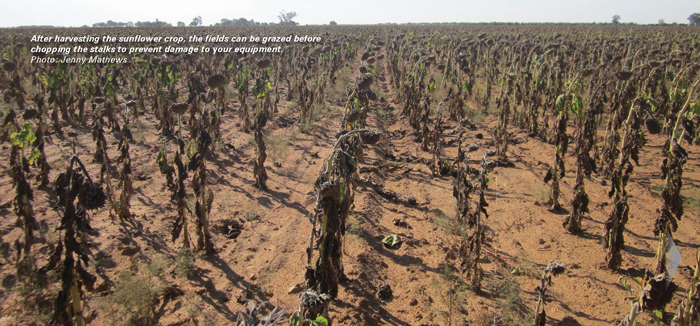July 2021
| JENNY MATHEWS, MANAGEMENT AND DEVELOPMENT SPECIALIST AND EDUCATOR |
 |
Plant residues protect the surface of the soil against the sun, wind and heavy downpours of rain that would normally wash precious topsoils away. Many farmers utilise the residue in some way or other, either as feedstock or material that enriches the soils.
A calculated decision must be made by the farmer in which he or she weighs up the benefits of grazing the feedstock against leaving the organic matter to increase the stability of the soil and improve water infiltration rates. However the bigger and thicker stalks of crops like sunflower and cotton can cause problems during tilling and planting operations. The stems and stalks of such crops do not break down fast enough and can clog machinery and damage tyres. It is therefore preferable to chop sunflower stalks left behind on the lands in preparing for the next growing season.
Sunflower stover is an undervalued feed source. While the stalks have little feeding value, there are always some sunflower heads left behind after the combining process. These heads have a high protein content and are excellent source of feed for grazing animals. A lot of farmers will therefore choose to graze the fields for a while until the heads have mostly been consumed before chopping the remainder of the sunflower crop residue.
CHOPPING THE SUNFLOWER STALKS
Farmers like to chop with a purpose designed stalk chopper soon after the harvest is taken off the land. The drier the stalks are, the better they break up and disintegrate. However if the stalks are still fairly wet when the crop is harvested, it is advisable to leave the stalks to dry off for a few weeks. This will occur naturally quite rapidly once the harvest is done and the plants have been damaged during the combining process.
Some farmers skip the chopping process and rather disc the lands with a heavy duty disc harrow. This however does not chop the stalks as effectively and they are not broken down small enough. It can hamper the pre-planting primary cultivation processes. If the long sunflower stalks are left in the lands, they can clog the machines such as vibroflex or rippers causing unnecessary stoppages. The mounds of stalks make piles in the field and are a problem when the farmer is trying to create a seed bed.
Another matter that needs consideration is the level of weed infestation in the sunflower field post-harvest. Often when late rains have fallen (as they have indeed done this 2021 season), weeds flourish and establish themselves in the fields.
Once the harvest is completed, these weeds need to be removed otherwise they will negatively impact the moisture levels in the soils. This could also make it difficult to do winter soil preparation as well as increase the weed seedbank in those fields.
Treatment of weeds is commonly done by doing a winter spray programme or otherwise a disking process must follow on after the stalks have been chopped. Weed control is important at every stage of the life cycle of the field.

Publication: July 2021
Section: Pula/Imvula